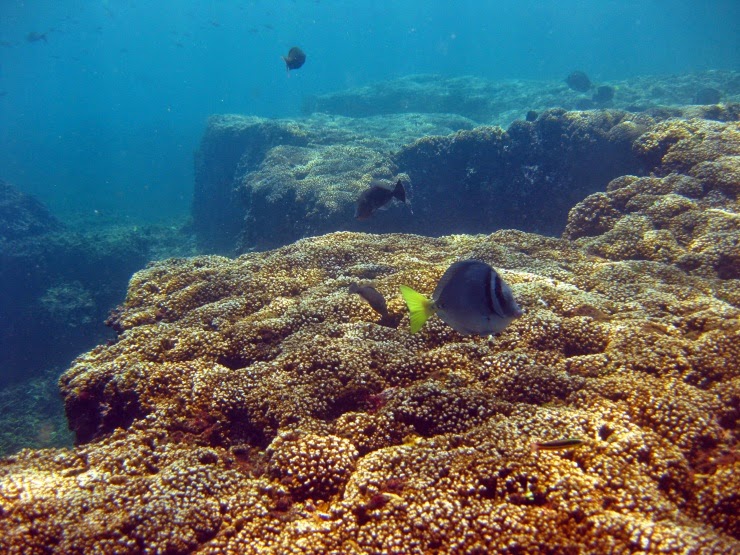
A new study has found that La Niña-like conditions in the Pacific Ocean off the coast of Panamá were closely associated with an abrupt shutdown in coral reef growth that lasted 2,500 years. The study suggests that future changes in climate similar to those in the study could cause coral reefs to collapse in the future.
The study found cooler sea temperatures, greater precipitation and stronger upwelling — all indicators of La Niña-like conditions at the study site in Panama — during a period when coral reef accretion stopped in this region around 4,100 years ago. For the study, researchers traveled to Panama to collect a reef core, and then used the corals within the core to reconstruct what the environment was like as far back as 6,750 years ago.
“Investigating the long-term history of reefs and their geochemistry is something that is difficult to do in many places, so this was a unique opportunity to look at the relationship between reef growth and environment,” said Kim Cobb, an associate professor in the School of Earth and Atmospheric Sciences at the Georgia Institute of Technology. “This study shows that there appears to have been environmental triggers for this well-documented reef collapse in Panama.”
The study was sponsored by the Geological Society of America, the American Museum of Natural History and the Smithsonian Institution’s Marine Science Network. The study is scheduled for publication on February 23 in the journal Nature Climate Change. The study was a collaboration with the Florida Institute of Technology, with Cobb’s lab providing an expertise in fossil coral analysis.
Climate change is the leading cause of coral-reef degradation. The global coral reef landscape is now characterized by declining coral cover, reduced growth and calcification, and slowdowns in reef accretion. The new study provides data to assist scientists in understanding how changes in the environment trigger long-term changes in coral reef growth and ecosystem function, which is a critical challenge to coral-reef conservation.
“Temperature was a key cause of reef collapse and modern temperatures are now within several degrees of the maximum these reefs experienced over their 6,750 year history,” said Lauren Toth, the study’s lead author, who was a graduate student at Florida Tech during the study. “It’s possible that anthropogenic climate change may once again be pushing these reefs towards another regional collapse.”
For the study, the research team analyzed a 6,750-year-old coral core from Pacific Panamá. The team then reconstructed the coral’s past functions, such as growth and accretion (accumulation of layers of coral), and compared that to surrounding environmental conditions before, during and after the 2,500-year hiatus in vertical accretion.
“We saw evidence for a different climate regime during that time period,” Cobb said. “The geochemical signals were consistent with a period that is very cool and very wet, with very strong upwelling, which is more like a modern day La Niña event in this part of the Pacific.”
In Pacific Panamá, La Niña-like periods are characterized by a cold, wet climate with strong seasonal upwelling. Due to limited data at the site, the researchers cannot quantify the intensity of La Niña events during this time, but document that conditions similar to La Niña were present at this site during this time.
“These conditions would have been for quite an extended time, which suggests that the reef was quite sensitive to prolonged change in environmental conditions,” Cobb said. “So sensitive, in fact, that it stopped accreting over that period.”
Future climate change, similar to the changes during the hiatus in coral growth, could cause coral reefs to behave similarly, the study authors suggest, leading to another shutdown in reef development in the tropical eastern Pacific.
“We are in the midst of a major environmental change that will continue to stress corals over the coming decades, so the lesson from this study is that there are these systems such as coral reefs that are sensitive to environmental change and can go through this kind of wholesale collapse in response to these environmental changes,” Cobb said.
Future work will involve expanding the study to include additional locations throughout the tropical Pacific.
“A broad-scale perspective on long-term reef growth and environmental variability would allow us to better characterize the environmental thresholds leading to reef collapse and the conditions that facilitate survival,” Toth said. “A better understanding of the controls on reef development in the past will allow us to make better predictions about which reefs may be most vulnerable to climate change in the future.”
Reference:
Lauren T. Toth, Richard B. Aronson, Kim M. Cobb, Hai Cheng, R. Lawrence Edwards, Pamela R. Grothe, Hussein R. Sayani. Climatic and biotic thresholds of coral-reef shutdown. Nature Climate Change, 2015; DOI: 10.1038/nclimate2541
Note: The above story is based on materials provided by Georgia Institute of Technology. The original article was written by Brett Israel.










